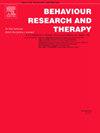在恐惧完全消退和强度降低时,非配对无条件刺激会减少再习得
IF 4.5
2区 心理学
Q1 PSYCHOLOGY, CLINICAL
引用次数: 0
摘要
在灭绝期间呈现不配对的无条件刺激(US)已被证明可以减少条件恐惧的情境更新并减缓重新获得。本研究调查了如果在消失期间呈现的美国强度低于在获得期间呈现的强度,是否也会观察到这种减少的恐惧回归。三组参与者(N = 121)接受了不同恐惧条件反射程序的训练,包括习惯化、习得、消退、更新测试和再习得阶段。为了诱导更新,在ABA设计中,在消光训练期间改变上下文。标准组在消光训练期间没有接受任何美国演示,而未配对组在消光训练期间以习得期间使用的物理强度接受了5个未配对的美国演示。未配对的USs强度在减少组减半。在习惯化、获得、消失或更新测试中,三组的皮肤电反应没有差异,在任何组中都没有观察到更新。然而,在标准消失后的第一个区域观察到显著差异的皮肤电反应,而在非配对消失后,无论美国强度如何,都没有观察到显著差异。这表明,即使以较低的强度呈现,未配对的美国呈现也能加强消退学习。这一发现开启了将非配对美国灭绝方法转化为应用环境的可能性。本文章由计算机程序翻译,如有差异,请以英文原文为准。
Unpaired unconditional stimuli during fear extinction at full and reduced intensity reduce re-acquisition
Presenting unpaired unconditional stimuli (US) during extinction has been shown to reduce the contextual renewal of conditional fear and to slow re-acquisition. The present study investigated whether this reduced return of fear is also observed if the intensity of the US presented during extinction is lower than that presented during acquisition. Three groups of participants (N = 121) were trained in a differential fear conditioning procedure that employed habituation, acquisition, extinction, renewal test, and re-acquisition phases. To induce renewal, the context was changed during extinction training in an ABA design. Group Standard received no US presentations during extinction training whereas group Unpaired received five unpaired USs during extinction at the physical intensity used during acquisition. The intensity of the unpaired USs was halved in group Reduced. Electrodermal responses in the three groups did not differ during habituation, acquisition, extinction or the renewal test where no renewal was observed in any group. However, significant differential electrodermal responses were observed on the first block of re-acquisition training after standard extinction, but not after unpaired extinction regardless of US intensity. This suggests that unpaired US presentations can strengthen extinction learning even if presented at a reduced intensity. This finding opens the possibility of translating the unpaired US extinction approach into applied settings.
求助全文
通过发布文献求助,成功后即可免费获取论文全文。
去求助
来源期刊

Behaviour Research and Therapy
PSYCHOLOGY, CLINICAL-
CiteScore
7.50
自引率
7.30%
发文量
148
期刊介绍:
The major focus of Behaviour Research and Therapy is an experimental psychopathology approach to understanding emotional and behavioral disorders and their prevention and treatment, using cognitive, behavioral, and psychophysiological (including neural) methods and models. This includes laboratory-based experimental studies with healthy, at risk and subclinical individuals that inform clinical application as well as studies with clinically severe samples. The following types of submissions are encouraged: theoretical reviews of mechanisms that contribute to psychopathology and that offer new treatment targets; tests of novel, mechanistically focused psychological interventions, especially ones that include theory-driven or experimentally-derived predictors, moderators and mediators; and innovations in dissemination and implementation of evidence-based practices into clinical practice in psychology and associated fields, especially those that target underlying mechanisms or focus on novel approaches to treatment delivery. In addition to traditional psychological disorders, the scope of the journal includes behavioural medicine (e.g., chronic pain). The journal will not consider manuscripts dealing primarily with measurement, psychometric analyses, and personality assessment.
 求助内容:
求助内容: 应助结果提醒方式:
应助结果提醒方式:


